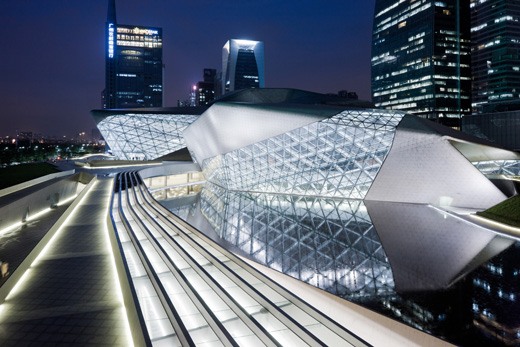Transformative architecture
Internationally renowned for her built, theoretical and academic work, Zaha Hadid is the founding partner of cutting-edge design firm Zaha Hadid Architects and the only independent woman to earn the coveted Pritzker Architecture Prize.
With over thirty years of practical experience in the interrelated fields of urbanism, architecture and design, each one of Hadid’s dynamic and innovative projects builds upon revolutionary experimentation and extensive research. Born in Baghdad, Iraq, in 1950, Hadid commenced her college studies at the American University in Beirut, in the field of mathematics. She moved to London in 1972 to study architecture at the competitive Architectural Association School of Architecture and upon graduation, she collaborated with the prestigious Office of Metropolitan Architecture working alongside mentors Rem Koolhaas and Elia Zenghelis.
Pointing towards painting and drawing, as well as Russia’s Avante-Garde artists, as inspiration, especially in her early period, Hadid transformed traditional drawing conventions, sometimes grafting several techniques and viewpoints together in the same multi-dimensional tableau. According to architect and critic Joseph Giovannini, she often layered drawings done on sheets of acrylic, creating visual narratives showing several spatial strata simultaneously. In addition to her new professional life as a practising architect, Hadid continued her academic connection to the Architectural Association as a teacher before launching her own practice in London in 1980. She gained recognition in 1983 by winning a much-published international competition for the design of the Peak, a sports club located in Hong Kong.

Giovannini describes “air” as Hadid’s element: “She floats buildings that reside aloft. At a time, in the early 1980s, when architects were concerned about manifesting the path of gravity through buildings, Hadid invented a new anti-gravitational visual physics. She suspended weight in the same way dramatists suspend disbelief. The Peak’s crystalline structure appears to explode from the mountainside, creating fragmentary fallout, a structure that evades any sense of unitary whole.”
Known as an architect who consistently pushes the boundaries of architecture and urban design, her work continues to experiment with new spatial concepts intensifying urban landscapes and encompassing all fields of design, from the urban scale to interiors and furniture. Her multi-faceted works are not only realisations of intense interest admired across the globe, but are also shown in exhibitions worldwide with many held in important museum collections.
Almost completed, Hadid’s Heydar Aliyev Centre is undergoing the final touches in Baku, the capital city of the Republic of Azerbaijan. Emerging from the surrounding landscape, her fluid structures provide a major new venue that will be a source of regeneration and redevelopment for Baku. The interior spaces are flooded with natural light via a glass façade and will welcome visitors to a state-of-the-art library, museum and conference centre through folds in its continuous outer skin. Commissioned by President llham Aliyev in 2006, the complex’s namesake is a recognised national leader of the Azerbaijani people and the building is purposefully designed to facilitate and encourage studies in the republic’s history, language, culture, national and spiritual values.
Rumour has it that not one straight line has been used in the complex’s construction, allowing an opportunity to connect the various cultural spaces whilst, at the same time, providing each element of the Centre with its own identity and privacy. As it folds inside, the outer skin erodes away to become an element of the interior landscape. With a soft opening held in May 2012, it is already an internationally recognised architectural work and is heralded as a signature landmark of modern Baku due to its innovative concept. The building made its screen debut in 2011 and was featured in Extreme Engineering, a documentary television series that airs on the Discovery Channel.
It was by pure coincidence that the 2004 Pritzker Architecture Award ceremony was hosted in the State Hermitage Museum in St. Petersburg, Russia, a serendipitous nod to Hadid’s creative roots. “The spirit of adventure to embrace the new and the incredible belief in the power of invention indeed attracted me to the Russian Avant-Garde,” she explains. “Studying the revolutionary Russian work I realised how Modern architecture built upon the break-through achieved by abstract art as the conquest of a previously unimaginable realm of creative freedom. Art used to be representation rather than creation. Abstraction opened the possibility of unfettered invention.”






















